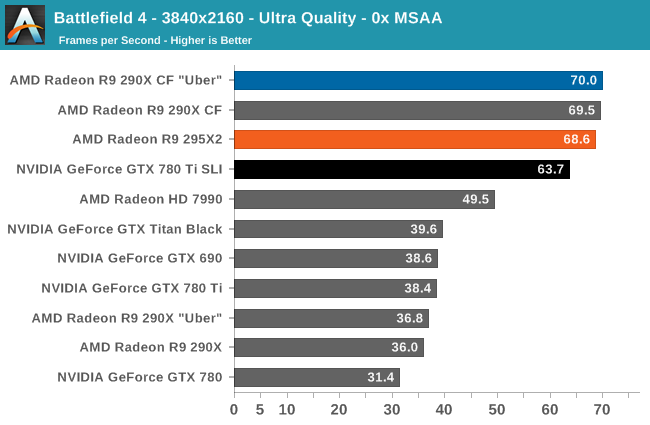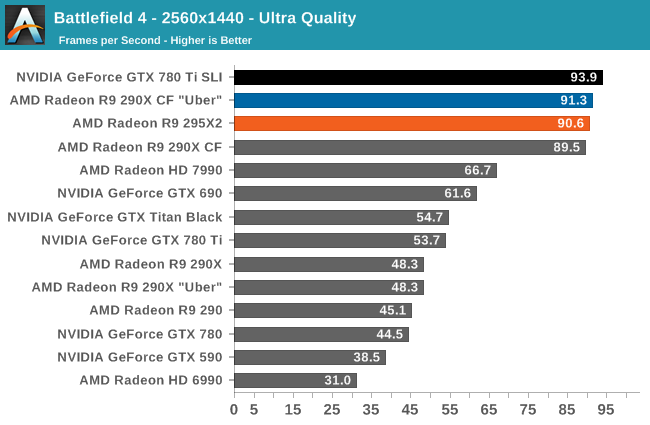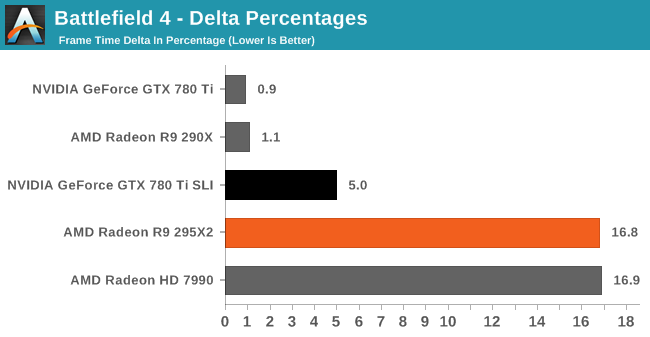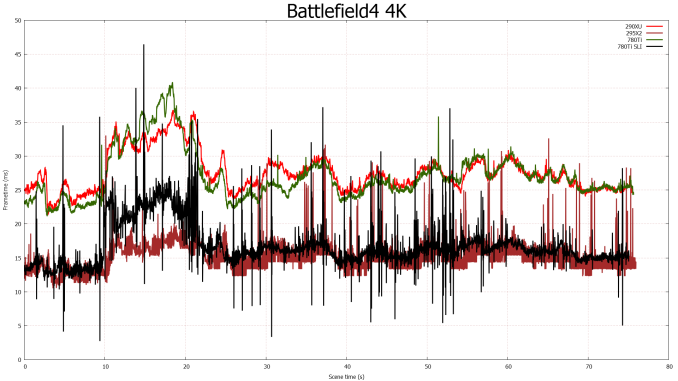The AMD Radeon R9 295X2 Review
by Ryan Smith on April 8, 2014 8:00 AM EST- Posted in
- GPUs
- AMD
- Radeon
- Radeon 200
Battlefield 4
Our current major multiplayer action game of our benchmark suite is Battlefield 4, DICE’s 2013 multiplayer military shooter. After a rocky start, Battlefield 4 has finally reached a point where it’s stable enough for benchmark use, giving us the ability to profile one of the most popular and strenuous shooters out there. As these benchmarks are from single player mode, based on our experiences our rule of thumb here is that multiplayer framerates will dip to half our single player framerates, which means a card needs to be able to average at least 60fps if it’s to be able to hold up in multiplayer.



As is the case in a few of our other games, whether it’s AMD who’s winning or NVIDIA who’s winning depends on the resolution. At 2160p with Ultra settings (and no MSAA) it’s AMD on top, with the 295X2 capable of delivering 68fps. This is safely past the 60fps threshold needed to ensure that minimum framerates don’t drop below 30fps in multiplayer. Otherwise at 1440p the NVIDIA GTX 780 Ti SLI setup pulls ahead, however the 295X2 is right on its tail.
In the meantime this game is also a good example of just how much faster than the 7990 the 295X2 is, despite the fact that both products are based on high-end (for their time) 28nm GPUs. The 295X2 ends up being over 40% faster at both 2160p and 1440p, showing just how far AMD has come in single card dual-GPU performance in the last year.


Shifting to our delta percentage benchmarks, we once more find that the 295X2 has no problem staying within the 20% threshold needed for smooth frame pacing. Though overall NVIDIA does hold an edge, especially at 1440p.












131 Comments
View All Comments
mpdugas - Wednesday, April 9, 2014 - link
Time for two power supplies in this kind of build...rikm - Wednesday, April 9, 2014 - link
huh?, no giveaway? why do I read this stuff?ok, seriously, love these reviews, but the thing I never understand is when they say Titan is better, but the charts seem to say the opposite, at least for compute.
lanskywalker - Wednesday, April 9, 2014 - link
That card is a sexy beast.jimjamjamie - Thursday, April 10, 2014 - link
Great effort from AMD, I wish they would focus on efficiency though - I feel with the changing computing climate and the shift to mobile that power-hungry components should be niche, not the norm.Basically, a dual-750ti card would be lovely :)
IUU - Saturday, April 12, 2014 - link
The sad thing about all this, is that the lowest resolution for these cards is considered to be the 2560x1440 one(for those who understand).Bigger disappointment yet, that after so many years of high expectations, the gpu still stands as a huge piece of silicon inside the pc that's firmly chained by the IT industry to serve gamers only.
Whatever the reason for no such consumer applications,thiis is a crime, mildly put.
RoboJ1M - Thursday, May 1, 2014 - link
The 4870 stories that were written here by Anand were my most memorable and favourite.That and the SSD saga.
Everybody loves a good Giant Killer story.
But the "Small Die Strategy" has long since ended?
When did that end?
Why did that end? I mean, it worked so well, didn't it?
patrickjp93 - Friday, May 2, 2014 - link
People should be warned: the performance of this card is nowhere close to what the benchmarks or limited tests suggest. Even on the newest Asrock Motherboard the PCI v3 lanes bottleneck this about 40%. If you're just going to sequentially transform the same data once it's on the card, yes, you have this performance, which is impressive for the base cost, though entirely lousy for the Flop/Watt. But, if you're going to attempt to be moving 8GB of data to and from the CPU and GPU continuously, this card performs marginally better than the 290. The busses are bridge chips are going to need to get much faster for these cards to be really useful for anything outside purely graphical applications in the future. It's pretty much a waste for GPGPU computing.patrickjp93 - Friday, May 2, 2014 - link
*The busses AND bridge chips...* Seriously what chat forum doesn't let you edit your comments?Gizmosis350k - Sunday, May 4, 2014 - link
I wonder if Quad CF works with theseBlitzninjasensei - Saturday, July 12, 2014 - link
I'm trying to imagine what kind of person would have 4 of these and why, maybe EyeFinity with 4k? Even then your CPU would bottleneck way before that, you would need some kind of motherboard with dual CPU slots and a game that can take advantage of it.